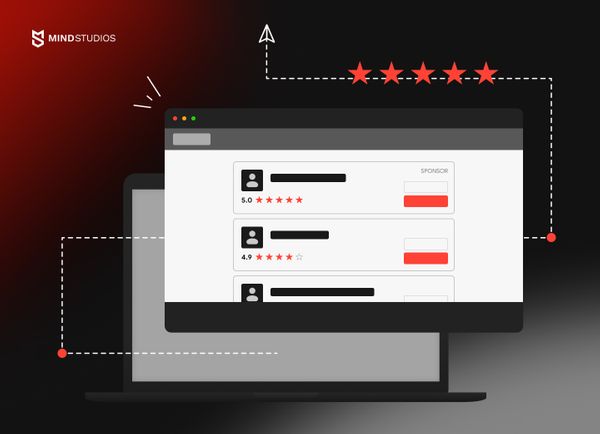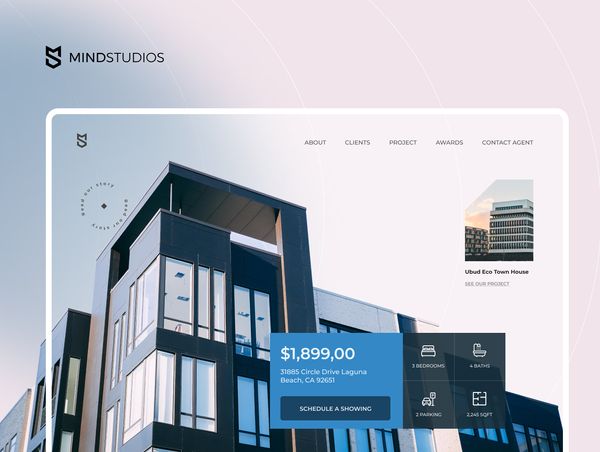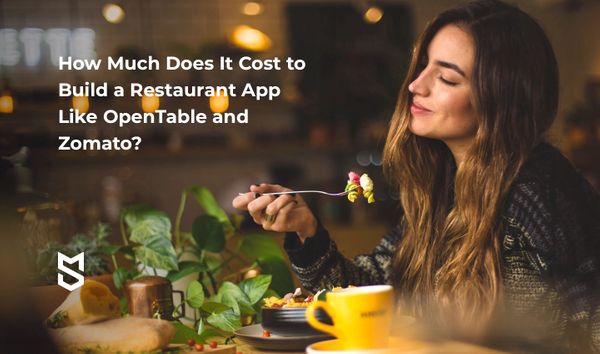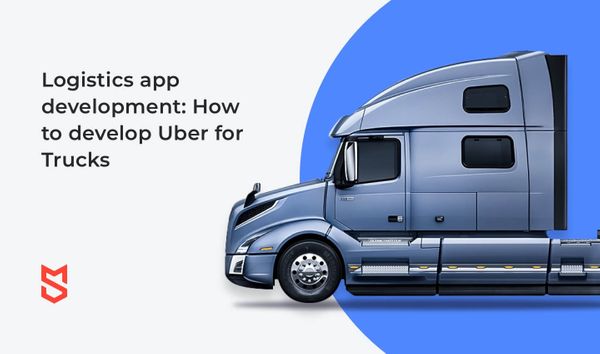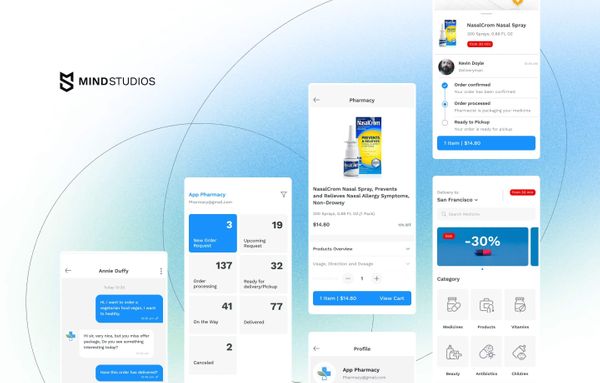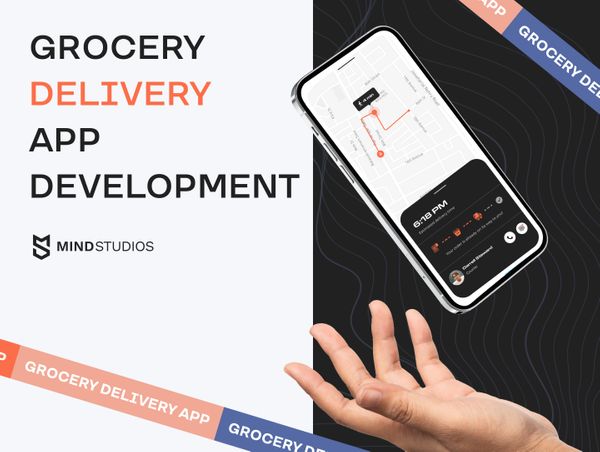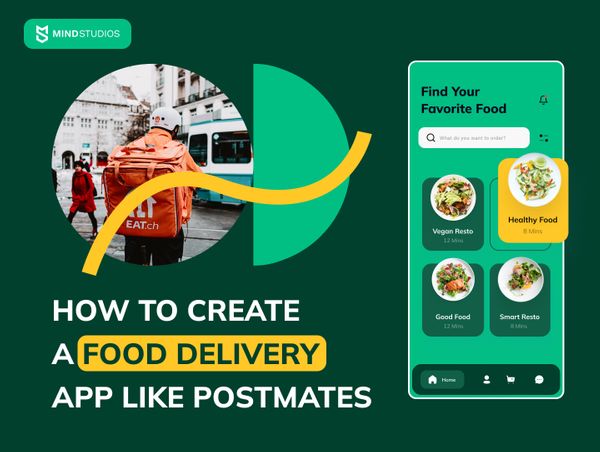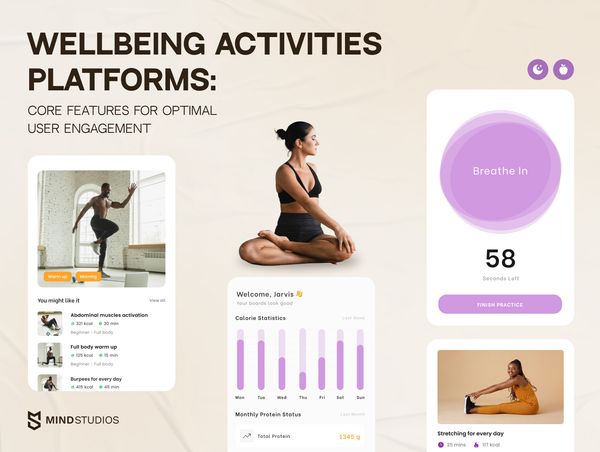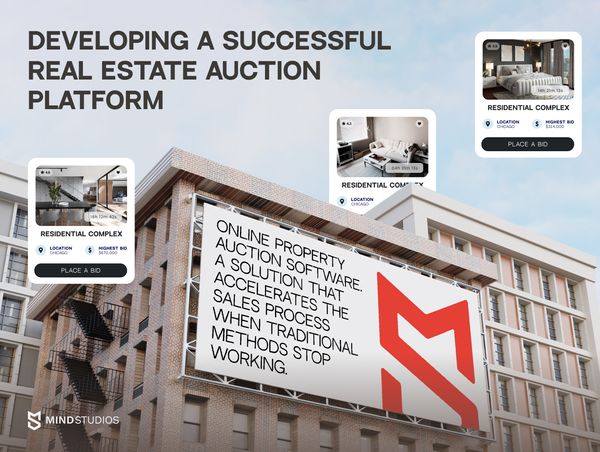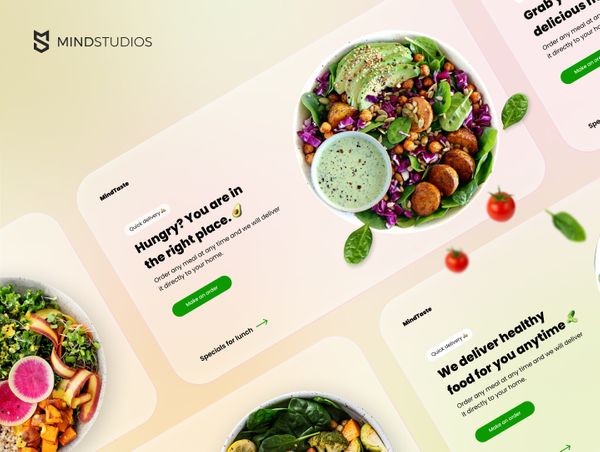
So you’re thinking of building a food delivery website. Are you going to build it from scratch or via a website builder? Will it be only a mobile-adapted website or also a native mobile app? Are you sure you really need to start with a website instead of a mobile app?
Thomas Eriksson was puzzled by similar questions when he appealed to us to launch his food delivery startup in Denmark. Thanks to the in-depth discovery stage, we figured out that a mobile app would be more convenient for users to order delivery than a website. Three months after the James Butler app's launch, it got 4639 registered buyers.
In this article, we theorize when it’s sensible to build a website and when — a mobile app. You can find here a complete guide to food delivery website development. We’ll analyze current market trends, look at the features a successful food delivery service needs, and calculate a rough estimate of the cost to build an on-demand delivery website.
Current market situation
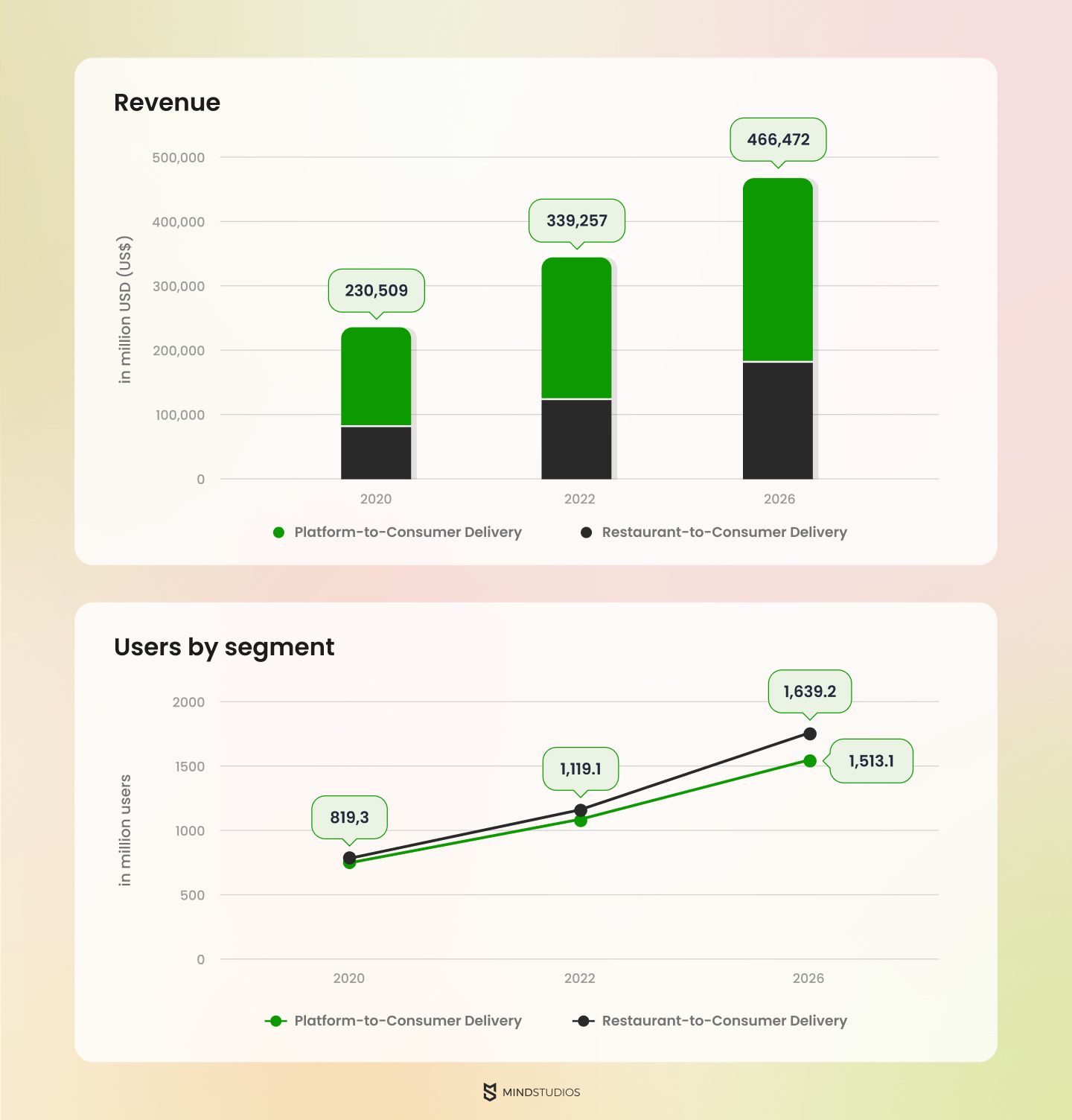
According to Statista, the number of food delivery service users is expected to almost double from 1.6B in 2020 to 3.1B by 2026, so is the food delivery market size. The global lockdown caused by COVID-19 gave a strong boost to the popularity of on-demand delivery services. It started from an increase of 47% in revenue ($230M) in 2020 to an expected volume of $339M in 2022 to a projected volume of $466M by 2026.
These factors place on-demand delivery services on the list of trending app ideas, generating a tremendous amount of new startups. Those who were backed by top-notch technologies and innovative solutions successfully attracted solid investments.
Some food delivery startups that in 2022 raised funds according to Crunchbase reports:
- On February 2, Kiwibot, a Miami-based startup founded in 2017, raised $7.5 million in funding in a Series A round for its special delivery robots that make food delivery easier and cheaper.
- On January 26, Cheetah, a San Francisco-based e-commerce platform founded in 2014, raised $60 million in a Series C round for its mobile fulfillment centers that provide contactless grocery pickup and delivery.
- Deliverest, a Belgium-based startup founded in 2018, got $150 million in funding from a Series D round on January 24 for its software that integrates online orders from third-party channels like Uber Eats, Glovo, and DoorDash into restaurants’ point-of-sale systems (POS).
To make a food ordering website marketable and profitable, you need to identify your unique value proposition — along with trends, innovations, and technologies you plan to use — that will set your service apart from competitors and entice users.
## Businesses that should get a custom online food ordering system
It’s a fairly widespread idea that custom ordering systems are worth the investment only for big restaurant chains. However, this isn’t necessarily true. All the advantages of online food ordering software we list below are valid regardless of the size of your restaurant business. Moreover, some of them might be even more important for a small business than a big one, especially if said business aims to grow.
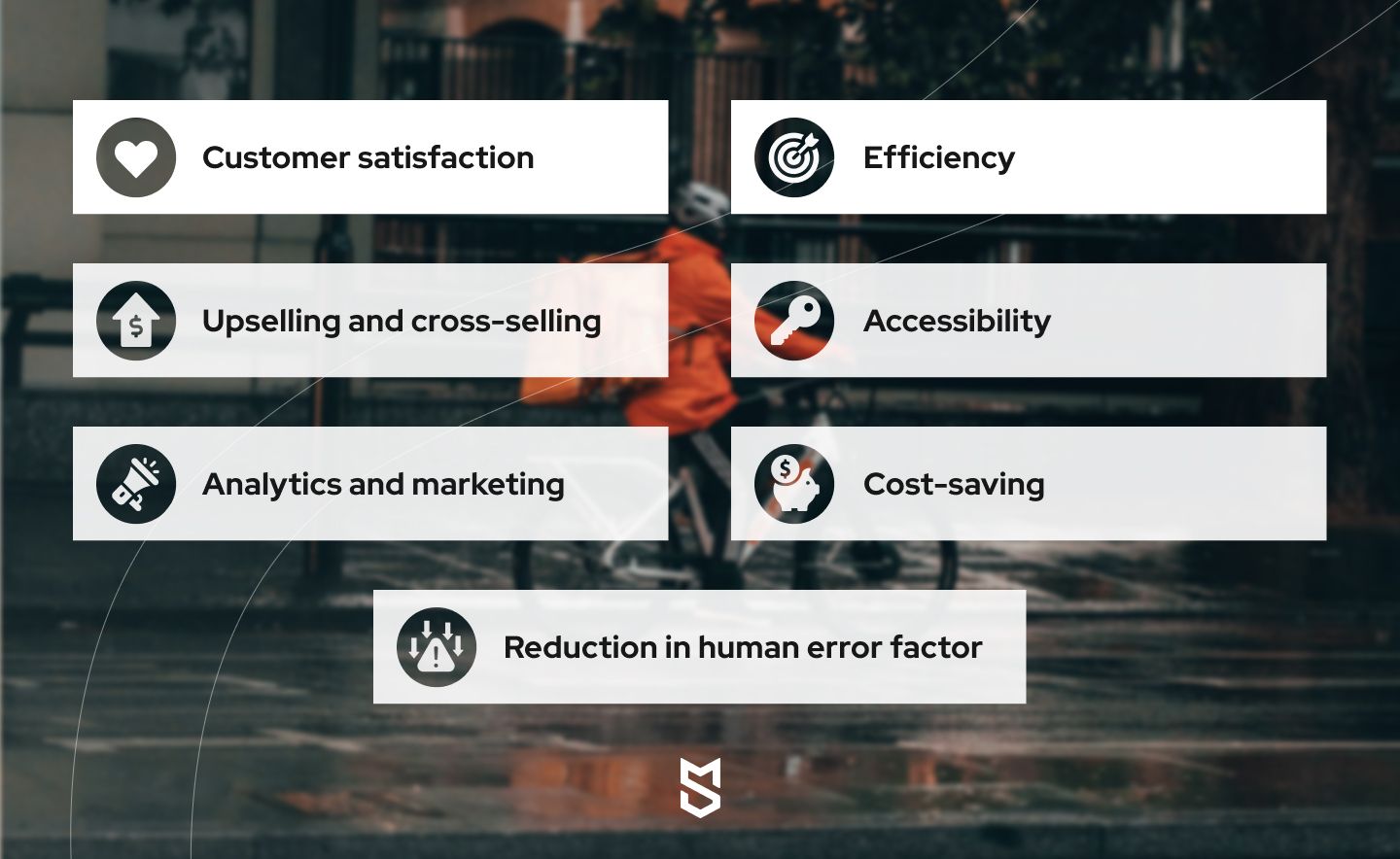
The benefits of a custom restaurant food ordering system include:
- Customer satisfaction. Simply having a landing page or even a website for your restaurant isn’t enough anymore. Diners expect to have a table booking functionality and order delivery right there. Moreover, online ordering is easier for customers: it offers visualization of items on the menu and removes the possible obstacle of miscommunication due to faulty phone connection or speech peculiarities (accents, speech/hearing disorders).
- Efficiency. By switching from a phone-based ordering system to an online ordering one, you’ll free time of your employees. Phone-based ordering means that an employee can only process one order at a time, whereas an online service can automatically process multiple orders while employees prepare them. This becomes more crucial the bigger your restaurant business is and the more orders you receive.
- Upselling and cross-selling. In a proprietary ordering system, you can offer your customers options what to add to their order based on personalized data.
- Accessibility. For people with speech or hearing disabilities, a phone-based service is hard to use. An online ordering system, on the other hand, can be configured to accommodate people with all kinds of disabilities: people with hearing issues will navigate a visual interface without problems, and you can implement a special interface for people with vision impairment, learning disabilities, motor impairments, etc.
- Analytics and marketing. This is a particular benefit you’ll get if you have a custom online food ordering system. Most third-party delivery services like Uber don’t share users’ in-app behavior information with restaurants they partner with.
Therefore, restaurant managers don’t know what users did in the app before they hit that make an order button. Whether they were looking for something specific and didn’t find it, or if they were browsing different sections of the menu; maybe they added an item to their order and then removed it before finalizing.
A custom system for your restaurant can be equipped with tools to better understand your users and tailor your marketing efforts (e.g. personalized discounts) for better results. This, in turn, will increase your customers’ loyalty to your restaurant. - Cost-saving. In the long run, maintaining an online ordering system is usually cheaper than maintaining a phone-based one.
- Reduction in human error factor. Misdelivered orders, delays, and errors in items delivered go down drastically with an online system. Customers choose items from a menu they see; they also can check if they put in their address and contact information correctly.
So, what kinds of restaurant businesses should think about investing in online food ordering systems?
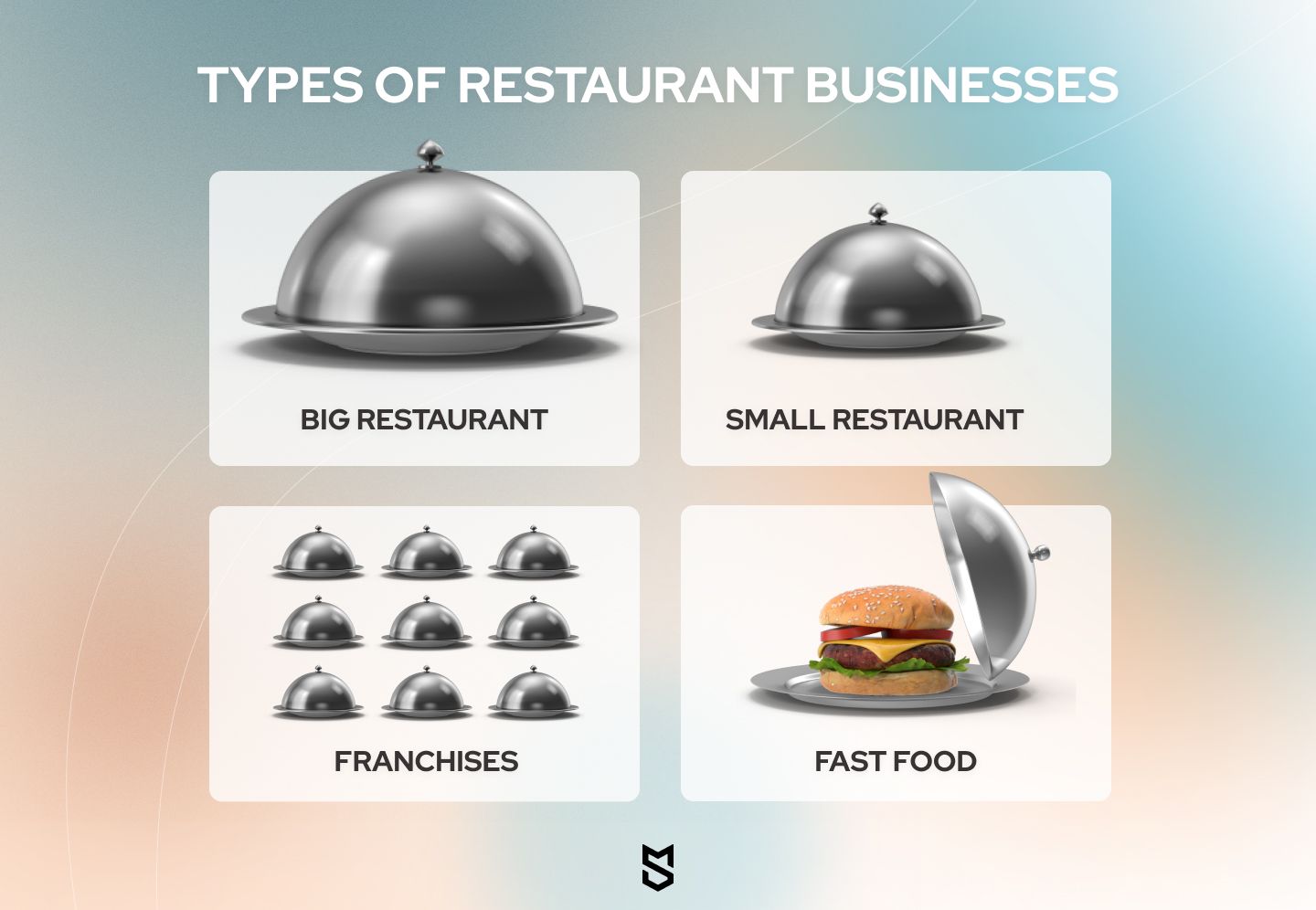
- Big restaurants with a lot of orders will benefit a lot from an online food ordering platform by streamlining order processing while eliminating the human error factor.
- Small restaurants with limited seating options can use third-party delivery services like Uber Eats for delivery and greater visibility, but if they plan to grow, proprietary ordering systems with analytics would be of great help.
- Restaurant franchises will also need analytics — for marketing as well as to adjust workforce allocation, funding, and menus.
- Fast food restaurants can use online ordering apps for automated order processing, to enhance the use of workforce and employee efficiency, or for upselling/cross-selling.
These are just the most prominent examples of how a custom restaurant food ordering system might be of use for all types of restaurants. Based on the specifics of your business, you might single out different benefits or, most likely, make use of them all.
## 5 cases when you should have a custom online food ordering system
The most straightforward reason for a restaurant business to create a custom ordering system is that such a system facilitates growth in many ways. In this section, however, we will talk about specific uses of online food ordering systems to enhance particular parts of your business operations.
#1 You want to increase customer satisfaction
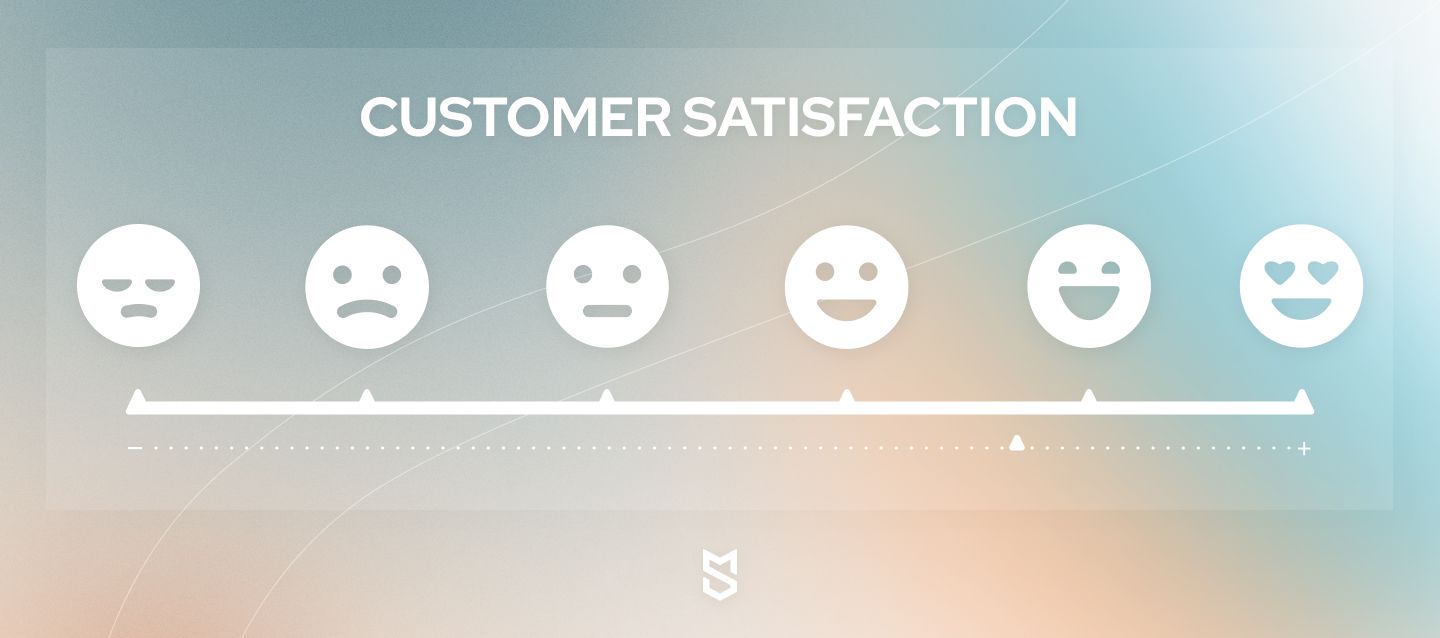
Customer satisfaction is the life of any restaurant. In older times, it was enough to offer tasty food at a reasonable price and your unique value proposition could come in the form of hiring a skilled violinist to entertain your patrons. Today, that’s not the way things are.
These days, customers demand food delivery with the high quality of service. Moreover, restaurant business is one of the most competitive niches anywhere in the world.
A food ordering system for restaurants will enhance customer satisfaction by taking some hassle out of the ordering process:
- Your customers won’t need to be kept on hold, waiting for the phone call to connect
- Time-to-order will shorten significantly
- Menu imagery will help customers choose what they want faster
- On-site menus can include dietary information for picky eaters
Technically, you can do all that by partnering with a third-party delivery service provider. However, on an aggregator platform, it would be hard to stand out from competitors. It’s more sensible to use such partnership for visibility and customer base expansion but have your own ordering system to offer better experience to your customers.
#2 You need data to facilitate your business growth
The biggest benefits of online food ordering systems, when we’re talking about custom solutions, lie in the realm of data. Custom systems can collect and analyze customer behavior, and such data is essential for business growth, marketing campaigns, seeking investments, and to allocate funds efficiently.
#3 You want to launch personalized loyalty offers
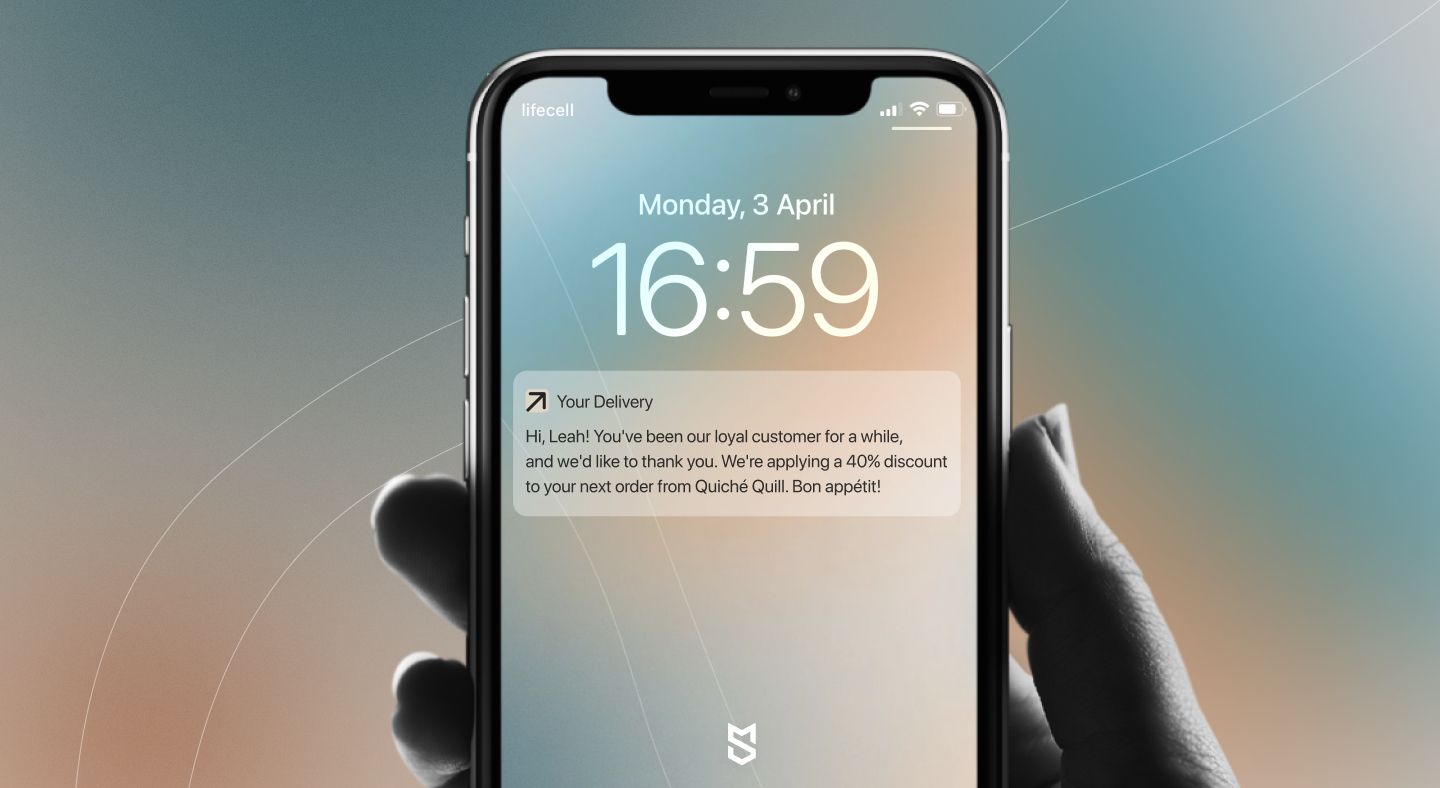
For customers, loyalty offers are a kind of bonuses for being the business’s patrons. For businesses, such programs are aimed at increasing customer loyalty. And data on customer behavior plays an important role in creating such programs.
By collecting customer behavior data on your ordering service, you can create discounts and other offers tailored to each customer (or a group of customers).
For example, you can use the following data to create a timed personalized offer for your customer:
- How often a customer places an order
- Date and time of orders
- What’s their most ordered menu item
This is a simple example, but more data will help you tailor your marketing efforts in a way that your customers will be really tempted to click that call-to-action button.
#4 You need to make order management more efficient
One of the major reasons for using online ordering for restaurants is that it frees your employees from phone duty, allowing you to allocate them to tasks a computer can’t yet perform.
This is especially true for restaurants during rush hours, when orders arrive in droves. With an online system, you’ll enhance customer experience and you’ll be able to use fewer people on order processing. Since a computer will compile lists of orders, employees previously busy answering phones and taking orders will be free to ready these orders for delivery.
#5 You’d like to communicate with your customers
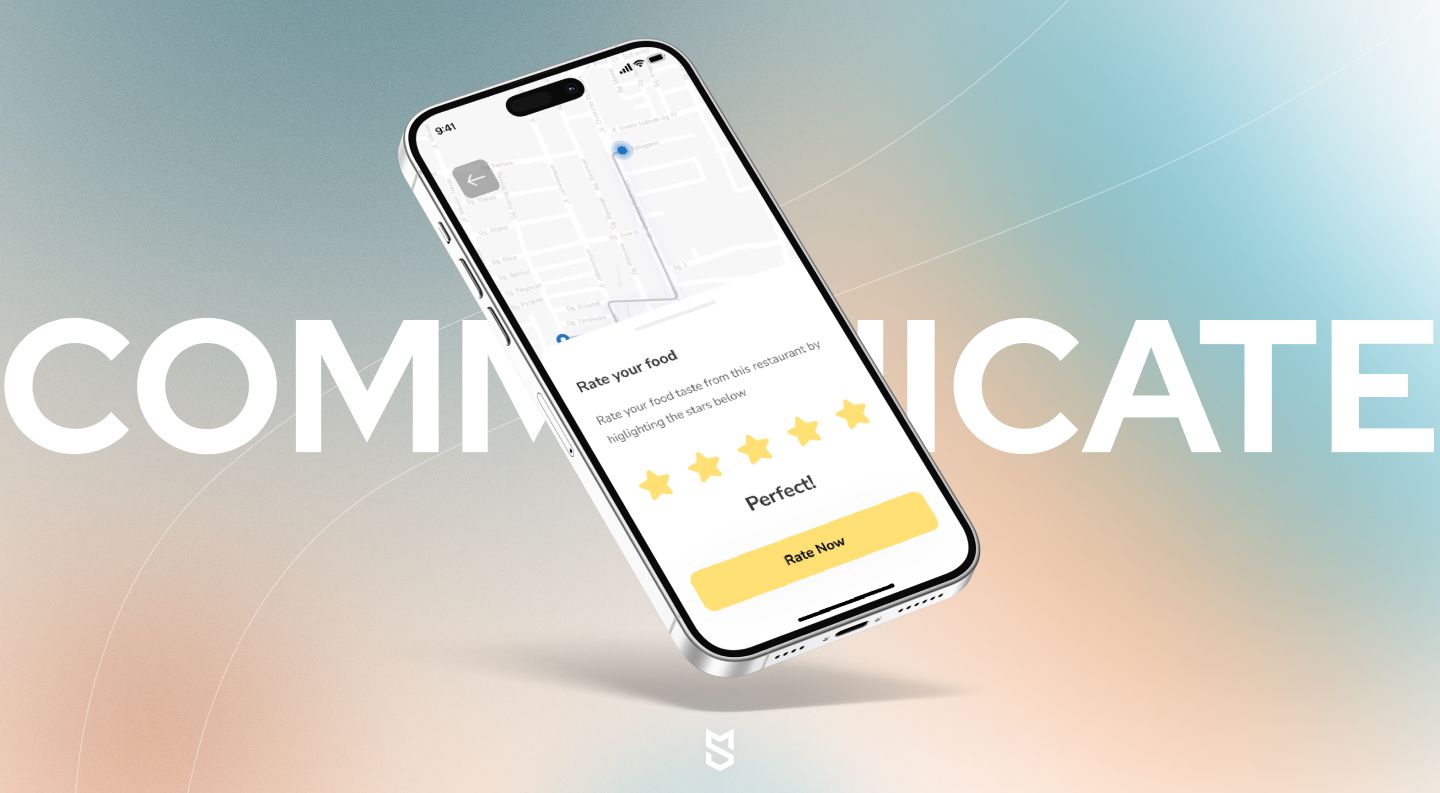
In apps like Uber Eats, Bolt Food, and similar ones, customer–restaurant communication is usually limited to user ratings and an option for a customer to call the delivery person. Sometimes, it’s possible for users to leave a review in the app, but very few diners actually do that.
An ordering service of your own provides your business with an opportunity to directly contact your customers, be it via email or in-app chat functionality. You can ask to rate the experience, food, and delivery quality, request feedback on the service itself, and directly market your business to users.
Are there any downsides to custom online food ordering software?
Generally speaking, the biggest possible downside to developing food ordering systems for restaurants is the development cost. Based on our experience, a web-based platform for taking restaurant orders can cost around $40,000, and a mobile app might require an investment of up to $35,000 per platform.
Compared to that, partnering with a third party service provider will seem cheaper. However, there are benefits to a custom system no third party will offer:
- Analytics tailored to your needs
- Focused software with no competition inside
- Direct communication with customers
- Free marketing opportunities
If you calculate the money you use to get all the data through third-party services, the cost of your broad-targeted marketing campaigns, and the cost of promotion in services like Uber Eats, you might be surprised to learn that in the long run, custom development is not as expensive as it seems.
Moreover, there are ways to save on development costs as well as spread out the spending so that it doesn’t hit as hard. Restaurant businesses that have in mind plans for growth and expansion definitely should consider investing in a custom online ordering system.
Food delivery marketplace: website or app?
You need to carefully choose the platform on which to launch your food delivery business. A mobile app allows more flexibility, letting users order delivery while commuting or while at a friend’s place. Our smartphones are with us even when we shower, after all.
On the other hand, building a food delivery website is faster than building an app, meaning you’ll start earning faster. It’s considerably less costly, too.
To identify the most efficient way to implement your food delivery service, you should take into account:
- market trends and local market specifics
- needs and preferences of your target audience
- competitors’ strengths and weaknesses
- your time and money limits
Without this data, all we can do for you now is share common tips about what to start with — building a website or a mobile app — to benefit your food delivery business:
| A food delivery website is good for: | A food delivery mobile app is good for: |
|
|
For example, creating a website was enough for Lyla Wolfenstein, a founder of Fully Belly Fire, to successfully build her Portland-based healthy food delivery business up from scratch in 2014. While she was experimenting with her crowdfunding campaign, forming her first customer base, and elaborating product labeling and packaging, her web designer was also tweaking the WordPress-based website. They integrated a custom-built CRM system via Drupal in the website and linked it to social media including Facebook, Instagram, and Twitter.
In the first two years after launching, the website quadrupled Lyla's customer base while expanding her delivery zone. Even now, having a $14K/month handcrafted dinner delivery company, Lyla is postponing a mobile app development instead refining her food delivery website design.
If you need to promptly validate your startup idea, it's sensible to start with developing a food ordering website. More so since in terms of design and development, it's easier to move from a web app to a mobile app than vice versa. You can always build a mobile app when you get a return on investment from your website.
Food delivery website development: ready-made or custom-built?
There are three ways you can get your food delivery website done: using a website builder, a content management system, or developing it from scratch. Let’s dive deeper into the pros and cons of each option.
Website builder: pros and cons
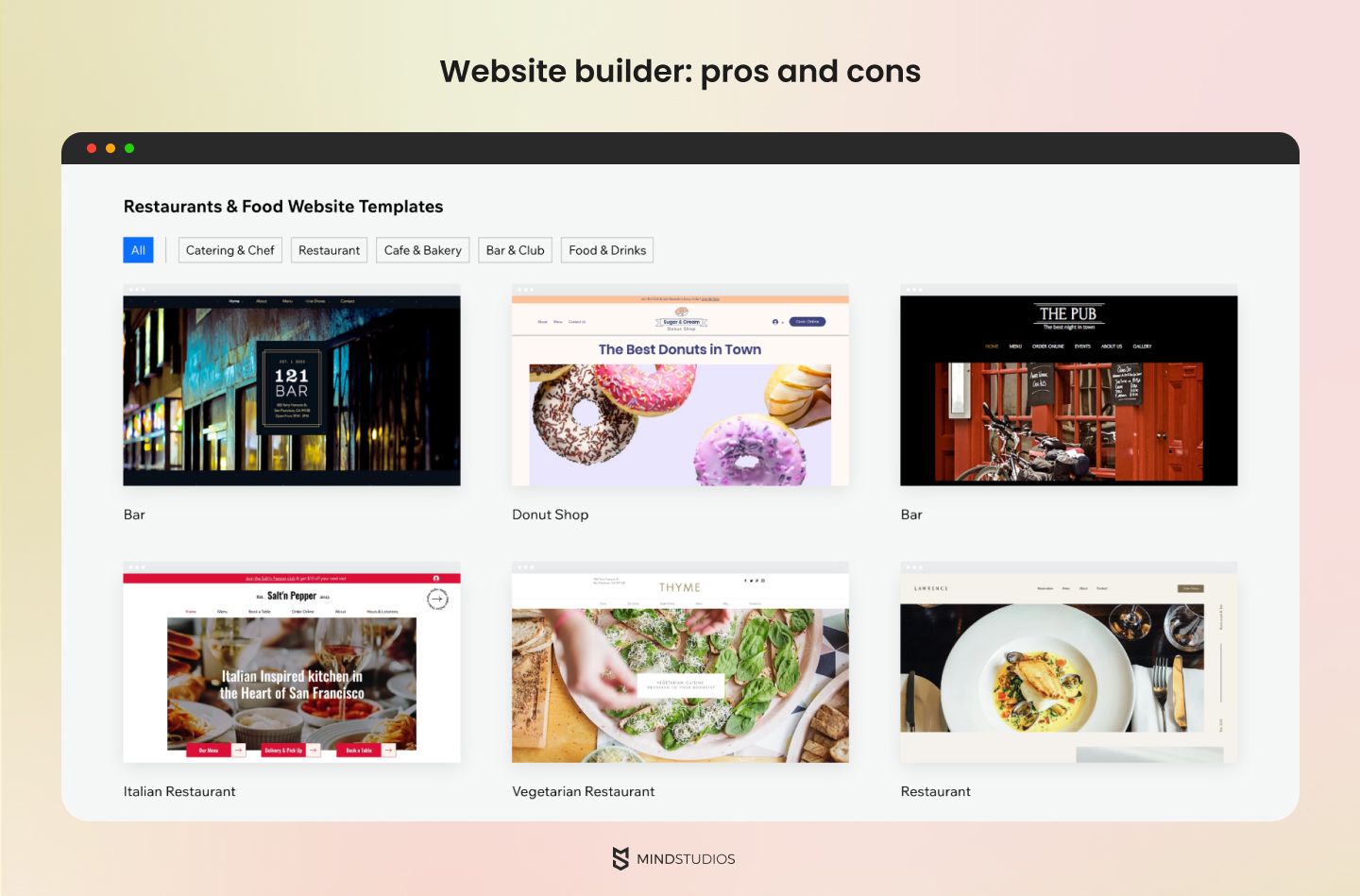
Today’s website builders promise you to get your food delivery website ready in a matter of minutes. Indeed, using ready-made templates and themes specifically designed for food delivery business needs, you can quickly:
- drag and drop website's blocks of content
- tweak pre-styled elements with your own logo, colors, fonts, and imagery
- get a web host, a domain name, an SSL/TLS certificate, and an SSD storage for like a couple dozen dollars a month
Sounds promising, especially since you don’t need any coding knowledge to create a delivery service website through a DIY website builder.
Despite all the reasons you might want to choose this option (budget, I suppose, would be #1), you also need to evaluate the risks which it may lead you to:
- Feature and design restrictions
- Poor mobile optimization
- Limited SEO capabilities
- Issues with storing lead data
- Third-party tool integration difficulties
- Hosting, ownership, and data security challenges
Content management system (CMS): pros and cons
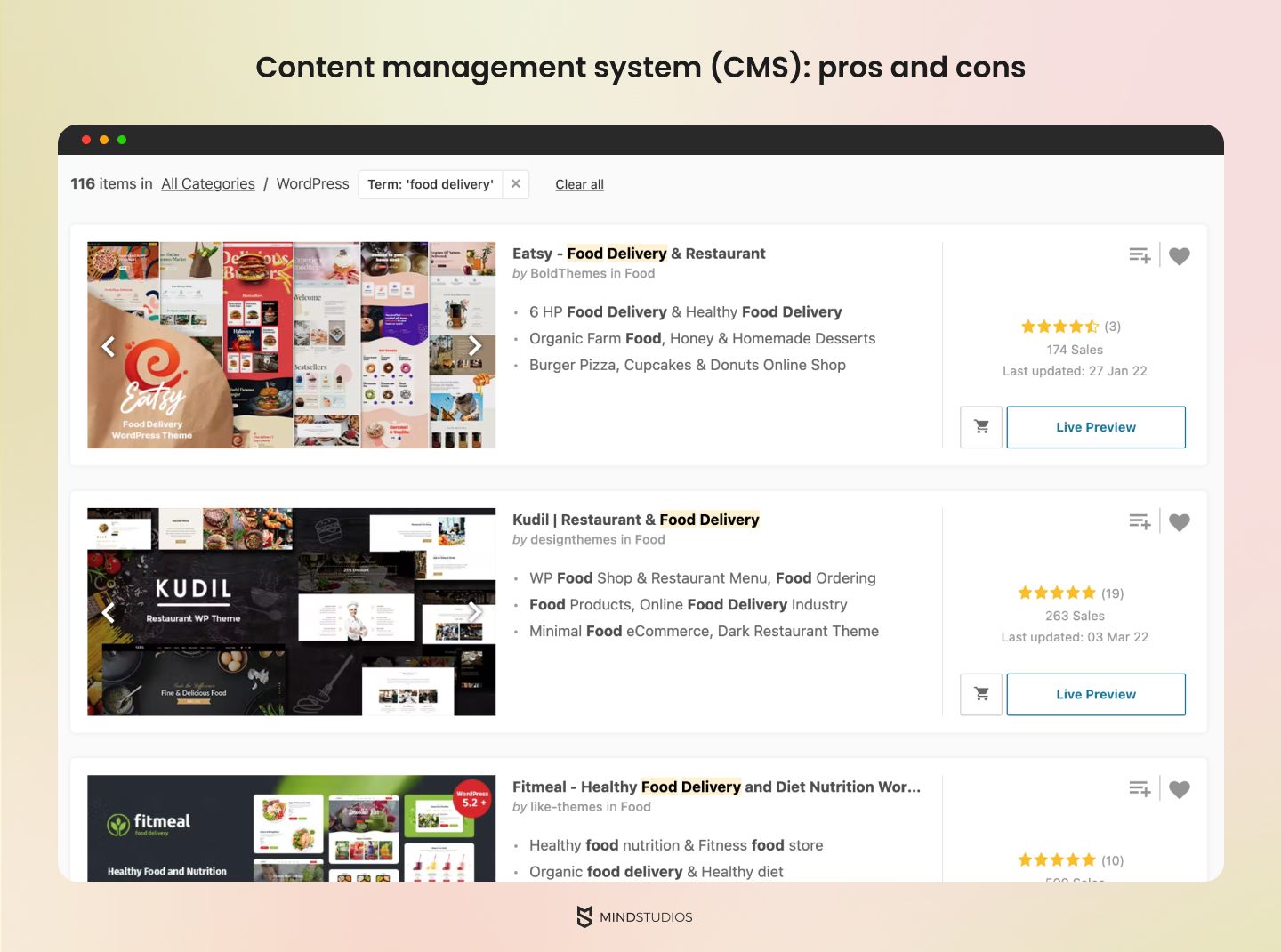
CMS software allows you to create a fully-fledged food delivery website including:
- a backend part where you can store a customer database with all the website content and files
- a frontend part where your text, images, video, and other content displays to users
- an admin panel where you’re able to load, style, publish content and manage the whole website
Unlike drag-and-drop website builders, CMS platforms store data in a more organized way, are more flexible in terms of UX design, and allow embedding your custom code as well as third-party add-ons. The cost of building websites on CMS platforms also pleases, meaning you’ll predominantly need to pay only for a domain name and maintenance.
What about the downsides of developing a food-ordering website using a CMS? They are not that few:
- Premium themes and plugins can be costly
- The more add-ons and extra added code, the lower the website speed is
- Extra technical skills required
- Database and vendor dependence
- Lack of portability
- Needs constant upgrading
Developing a website from scratch: pros and cons
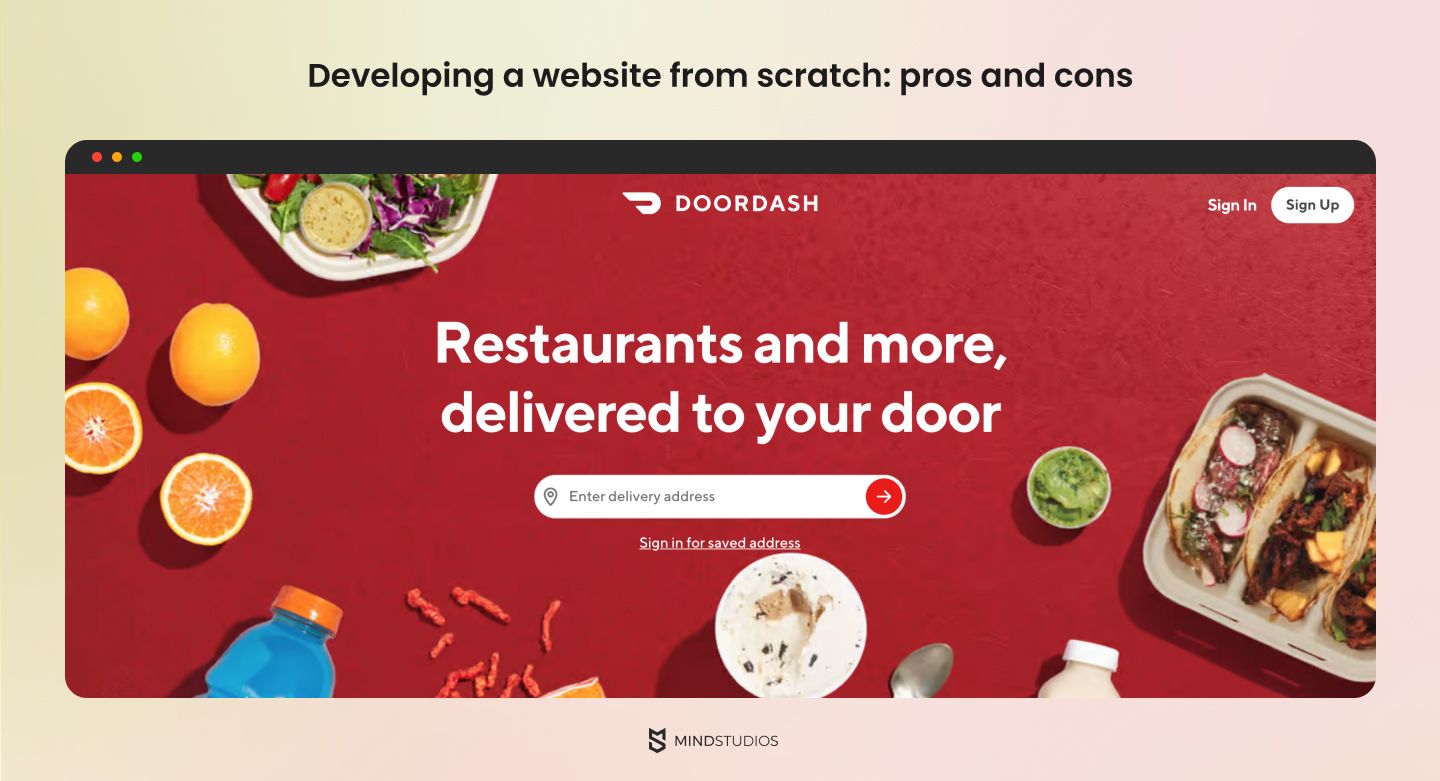
If you make a website for food delivery service from scratch, it means you’ll have the flexibility to realize unique interface design, any feature scope and complexity, as well as any third-party add-on incorporation. You can opt for the best tools to custom development including:
- Databases and cloud-based storage
- Content delivery network (CDN) to increase your website performance
- Application programming interfaces (APIs) to provide a wide range of website functionality
- Post-launch maintenance and upgrades
Apart from requiring broad programming knowledge, building a food delivery website from scratch tends to be time-consuming and pricey, unless you hire a team of professional developers with relevant experience.
In case when you plan to start a low-risk, low-cost business or locally test your startup idea on a small number of early customers, it makes sense to rely on website builders like Wix or Squarespace or content management systems like WordPress or Joomla.
If your goal is to expand your business to GrubHub or DoorDash scale, provide unique user-friendly service, or match the latest market trends, a food delivery website development from scratch will be your go-to option.
Types of online meal delivery services
Historically, from 78% to 93% of total profit that US-based restaurants received from customers has been used to cover expenses on food, labor, and occupancy leaving a tiny profit margin of between 7% to 22%. During the pandemic, when restaurants had to get on tracks of doorstep delivery, the received revenue was insufficient for covering the third-party services’ delivery fees, which resulted in negative margins.
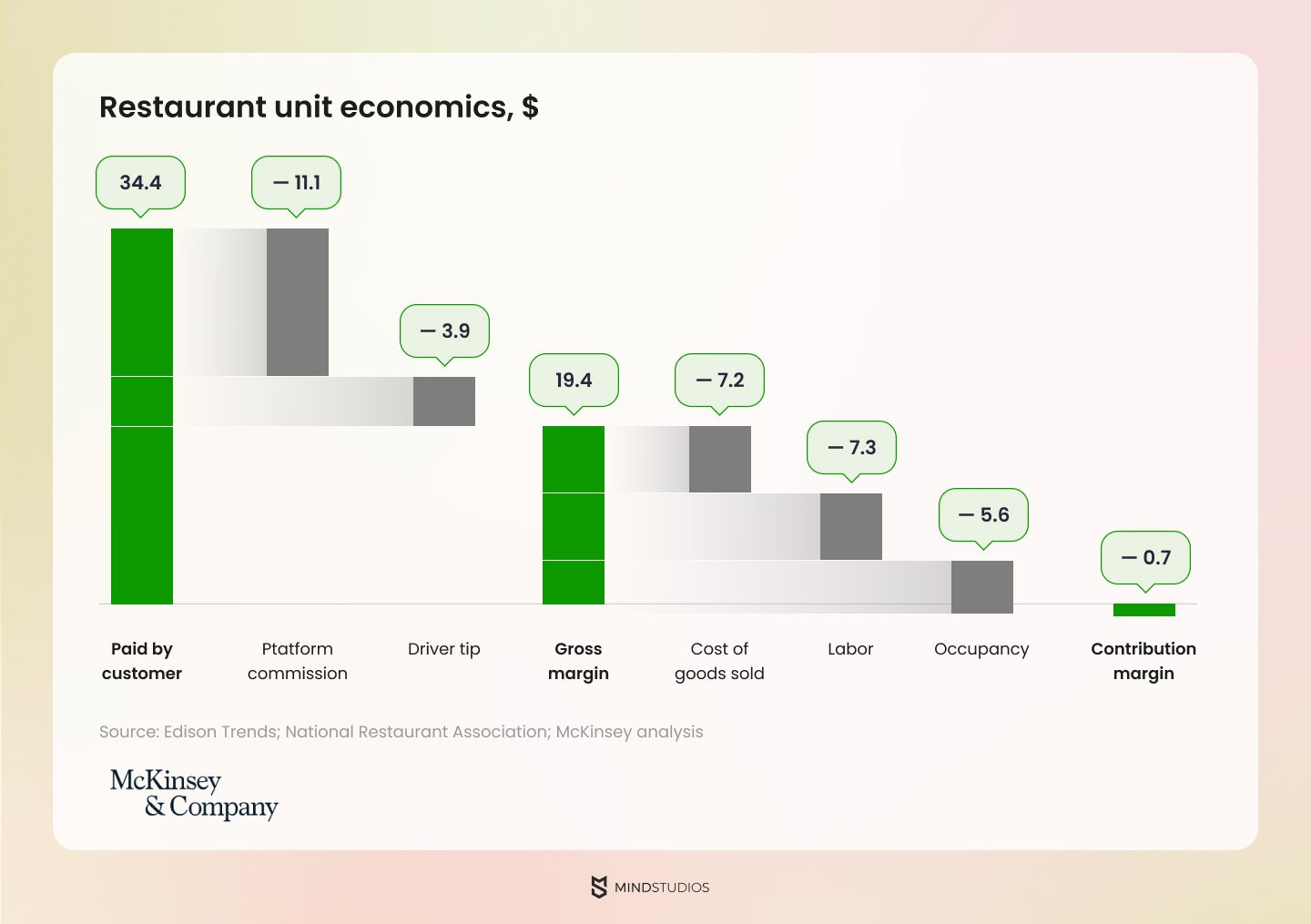
Since then, the lower-overhead food delivery business models including “dark kitchens”, delivery-first, and delivery-only food venues have become more and more popular.
Your site’s features and approach will differ depending on your business type. To help you choose it, below we share a detailed review of two main on-demand delivery business types.
1. Stores and restaurants that offer their own delivery
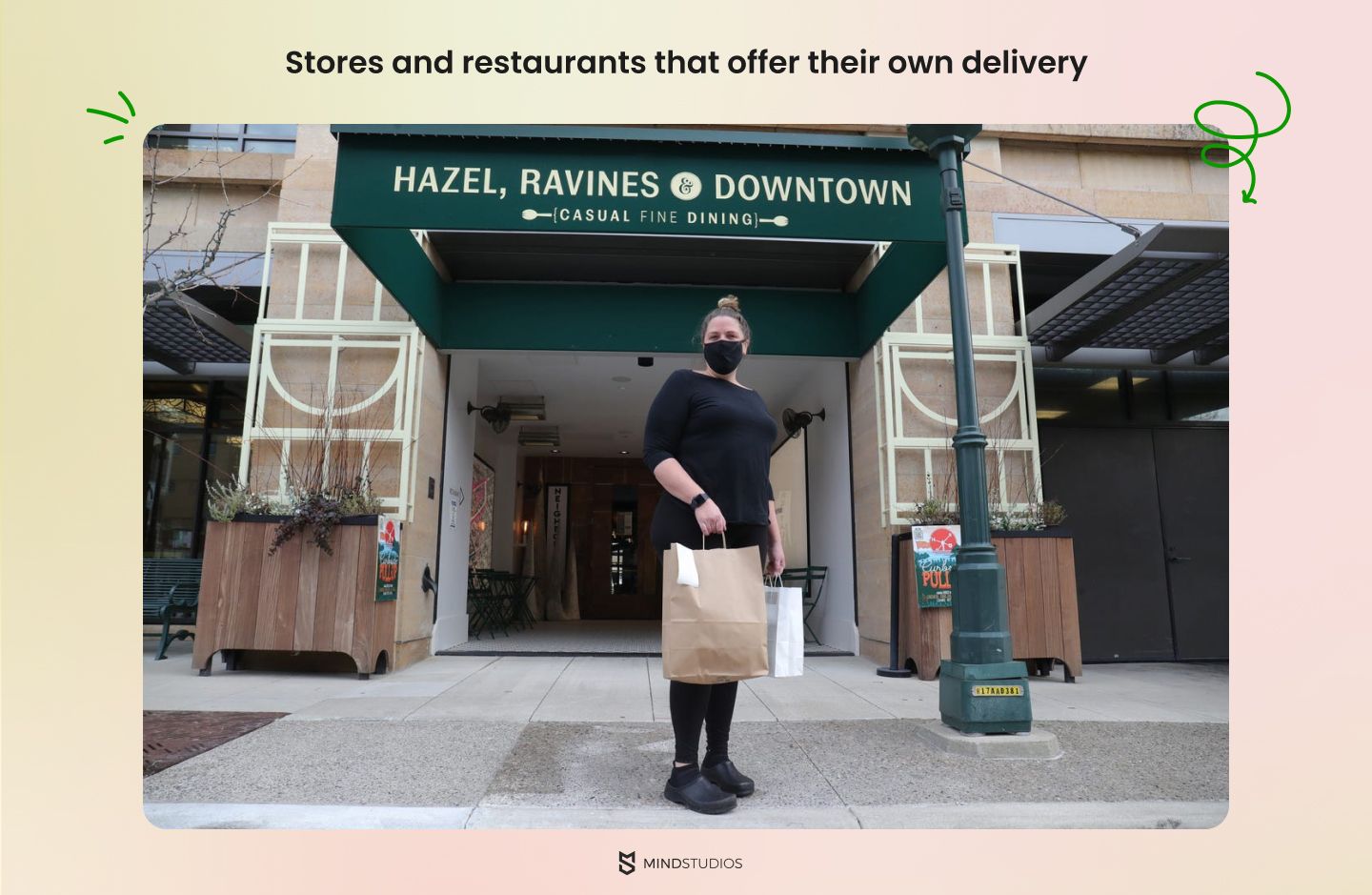
Most big stores, cafés, and restaurants have websites even if they don’t deliver food. Websites are efficient marketing channels — they allow establishments to list their products, hold and advertise events, offer contact information, and inform customers of sales, new hours, and any business changes.
If you’re a food venue owner and wish to expand your operations by adding a delivery service, you have two options:
- Update your website with new features and create your own delivery service (by couriers, drones, autonomous robots, etc.)
- Connect with an on-demand delivery platform that can arrange deliveries for you
The pros of doing your own delivery are that you can set your own rules and engage directly with your customers. You’ll be able to create a customer database and build targeted marketing as well as adjust your menu based on direct feedback from people who buy your food.
The biggest con of having your own delivery service is usually the cost. You’ll not only need to update your website (which you might want to do anyway as there are many reasons to update a business website) but also pay for couriers and vehicle maintenance. Maintenance costs can be lowered by delivering orders on foot or by bike instead of by car.
Another way to reduce costs is to shift away from traditional restaurants’ front of the house for customers and operate as dark or ghost kitchens. This means that your catering venue will provide takeaway-only services instead of serving food to patrons. You might be able to lower prices for customers, afford to pay third-party platforms’ higher delivery fees, and get your venue featured more conspicuously in the platforms’ apps.
However, hiring a third party to deliver orders also contains drawbacks.
Delivery platforms can also cost a lot — usually, they take a share of the total for each order. They also don’t share their databases with restaurants, meaning the only way to market through them is by paying to be placed at the top of the list. Depending on the fees a delivery platform sets and the size of your business, you might fare better by having your own delivery service.
2. Delivery services that work with multiple venues
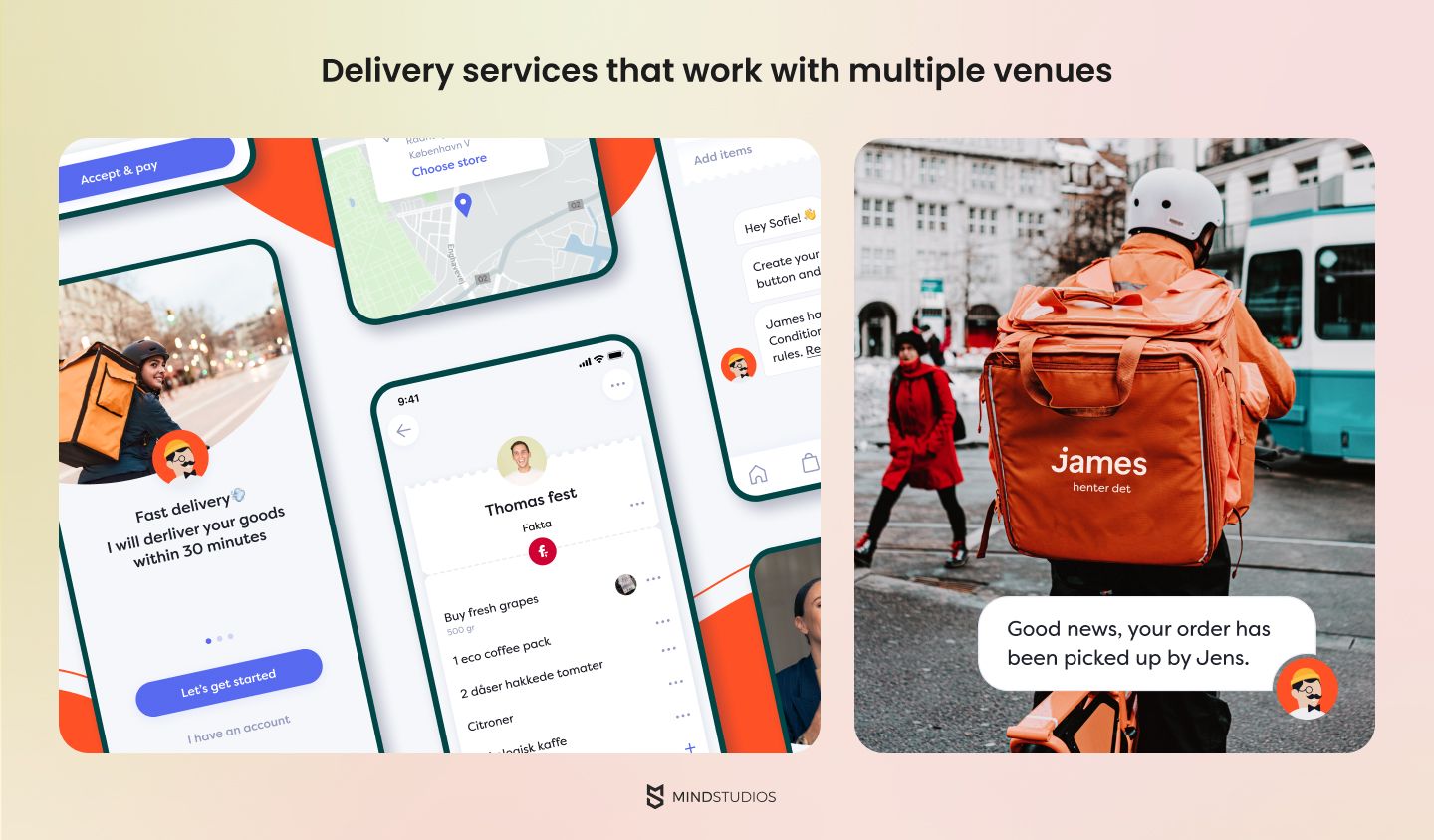
The other type of delivery service is an aggregator platform. These services don’t prepare food and only deliver it from third-party venues. Most people who search for information about how to build a food delivery website plan to offer this type of service.
Delivery services usually earn money by charging restaurant owners and, in most cases, customers. Fees differ from service to service and country to country, but the average in the US is 15% to 30% from each order on the restaurant’s side and $2 to $15 (depending on the order size) on the customer’s side.
For small businesses, 30% from each order might be a significant number, which is why some restaurants prefer making deliveries themselves. However, these fees are also charged by industry leaders like Uber Eats and Postmates.
Startups can win over smaller establishments by providing cheaper services.
For example, while Uber Taxi has been very successful in Ukraine, Uber Eats seems to have been pushed out by more affordable local services. Uber Eats was in the Ukrainian market for about a year before deciding the growth rate wasn’t good enough; the Spanish Glovo and Ukrainian Rocket seem to be flourishing, though, making us think it might be an issue with either Uber’s fees or its late arrival in the country.
Launching in a country or city where there are no giants present gives your business a high chance of successfully conquering the market before they arrive.
How to make a food delivery website
Analyzing the market you’re going to enter is the least you need to take to create a successful delivery website. No less important is to know your target audience preferences and needs. The better you'll meet them, the more feedback you'll get, the better you'll polish your website and boost the demand for your service.
For example, if you want to build a food ordering portal for Dubai, who will be your target users? Chances are, they’ll be luxury travelers. What issues do they tend to have regarding food delivery? Probably, there’s a ton of them but one of the most popular is having a fridge full of food (grocery, restaurant dishes, beverages, etc.) by the time travelers check into their booking apartments. If your food ordering website offers a fridge-stocking delivery service, it might have great success.
When I talked to Adrienne Han, a Vice President of CurrentFoods, a San-Francisco-based venue that creates seafood from plants named by Times as one of the best inventions of 2021, she also highlighted the importance of understanding target users’ behavior for building efficient marketing campaigns. Since their customers are vegans, vegetarians, and people who stick to healthy meal, CurrentFoods promotes its trademark via influencers including nutrition, fitness, and yoga coaches. Adrienne also mentioned they partner with tequila distributors since many people prefer to use boiled shrimp or other seafood like tequila snacks.
With extensive data on the market, competitors, and users, you'll be able to create a solid foundation for building a profitable delivery platform. To help you learn how to build a food delivery website seamlessly, we've prepared the nine-step guideline.
1. Define the interface for your food delivery website
First of all, if you’re building a platform that connects businesses and customers, you need to build two different interfaces plus an admin panel and a back end/server side. So there will be four parts in total:
- Customer interface
- Restaurant interface
- Admin panel
- Server software
Also, there’s the additional issue of a fleet. If you’re planning a service like Uber Eats where drivers can sign up and pick what orders they deliver, you’ll also need an app for drivers. In this case, we recommend going with a mobile app rather than a website.
Or you can forego the driver-side app by having coordinators who sort orders from the admin panel and assign them to delivery personnel. Sort of like taxi services did before Uber and its clones took over the market.
2. Must-have features that can be added
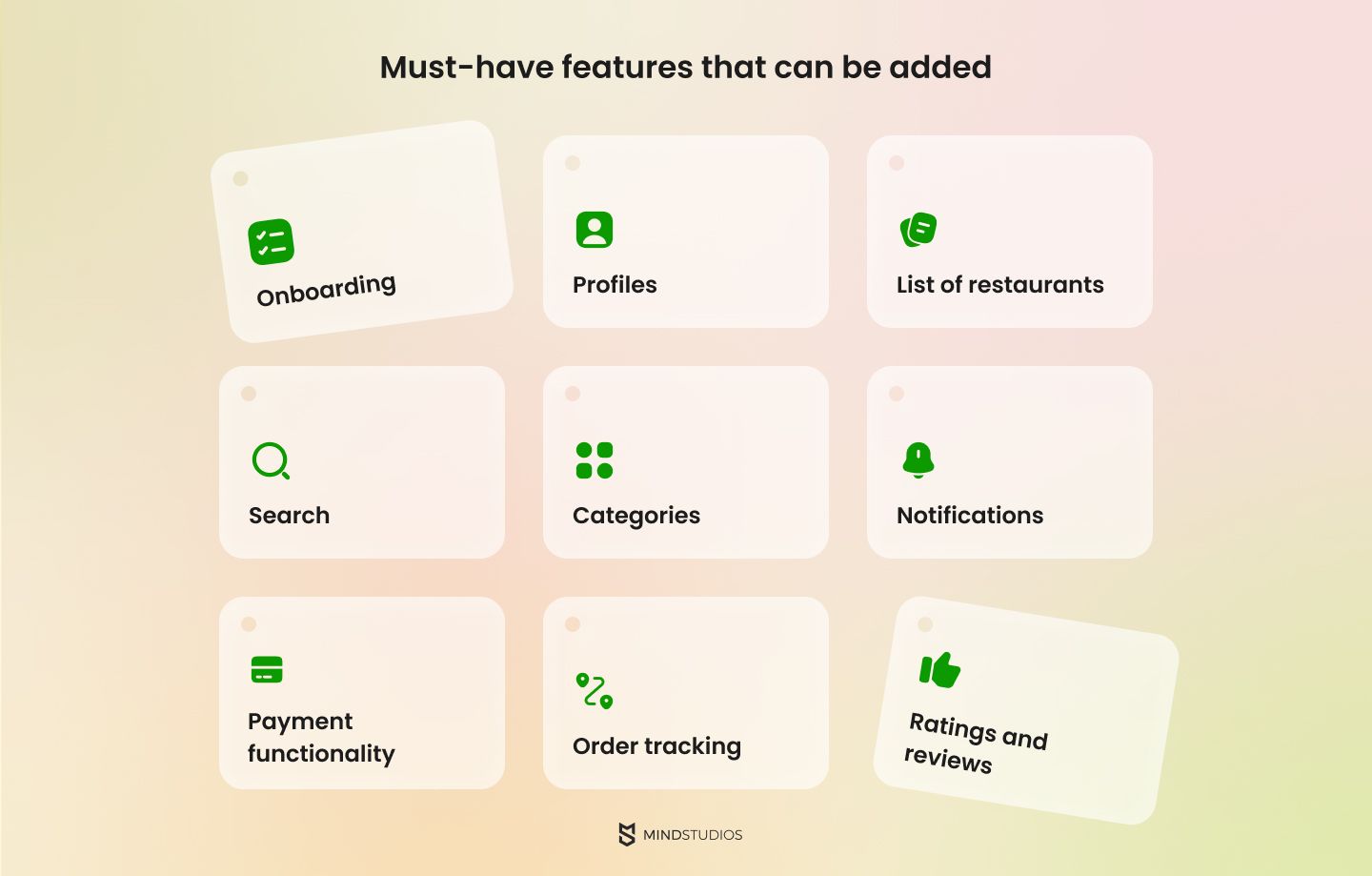
Developing a food-ordering website isn’t very difficult for an experienced development company. This kind of software doesn’t need many features.
To build a local food delivery website, consider building these features (on the customer side):
- Onboarding
It’s best to integrate sign-up via Facebook and Google in addition to the standard email and password option. This will significantly shorten the registration process, which is always a good thing for customers. - Profiles
Profiles are where customers’ data will be. The simplest set of fields includes name, delivery address(es), phone number, and email. If you’re going to support card payments, card details should be here too. Keep in mind that all this data is considered sensitive, meaning you’ll need to use the latest security certificates and means of data protection. Also, it’s good to keep an order history. Customers might want to repeat orders or simply keep track of what they’ve ordered. - List of restaurants
This is the list of all establishments your service delivers from. It’s possible to make some extra revenue by offering promoted listings that are shown at the top of the list for a fee. However, this is more relevant for services that have been on the market for some time and have a lot of partners. - Search
Searching by restaurant name and/or particular food will make the user experience smoother and more pleasant. - Categories
If you’re delivering from multiple types of restaurants, it’s wise to provide categorization so customers can sort venues. It’s logical to offer cuisine categories at the very least. For example: fast food, grill, Asian, seafood, vegan, fruits, cake, ice cream, alcohol, coffee, etc. - Notifications
Notifying customers about the status of their orders is a must. Whether an order is being delivered soon or the restaurant is out of a certain item, customers want to know. It’s possible, of course, to have a courier call the customer, but that might be inconvenient — like when someone orders lunch to their office and is in a meeting when the courier arrives. A web notification or text is more subtle and useful. - Payment functionality
Paying with cash upon delivery is becoming less popular each year, and the world is moving to digital payments rather swiftly. Integrating a payment gateway is important when building a food delivery website. - Order tracking
Order tracking isn’t strictly necessary, but many customers appreciate it. You can make it simple by just displaying order statuses (order accepted, preparing, handed to the courier, on its way, knock-knock!). Or you can integrate a map and real-time tracking system, although this will require an app for couriers that can track their real-time locations. - Ratings and reviews
Also an optional feature, ratings and reviews can offer your service valuable insights into what cuisine and what establishments are most popular and which places might offer low-quality food. Besides, people love to rate things, and many online shoppers check reviews before placing an order.
Your restaurant-side app will have an even smaller set of features. Each restaurant needs its own account with a dashboard. There, they should be able to accept or reject orders, change order statuses (accepted, preparing, handed to the courier), see a history of orders, and check how much money they've earned.
3. UI/UX Design
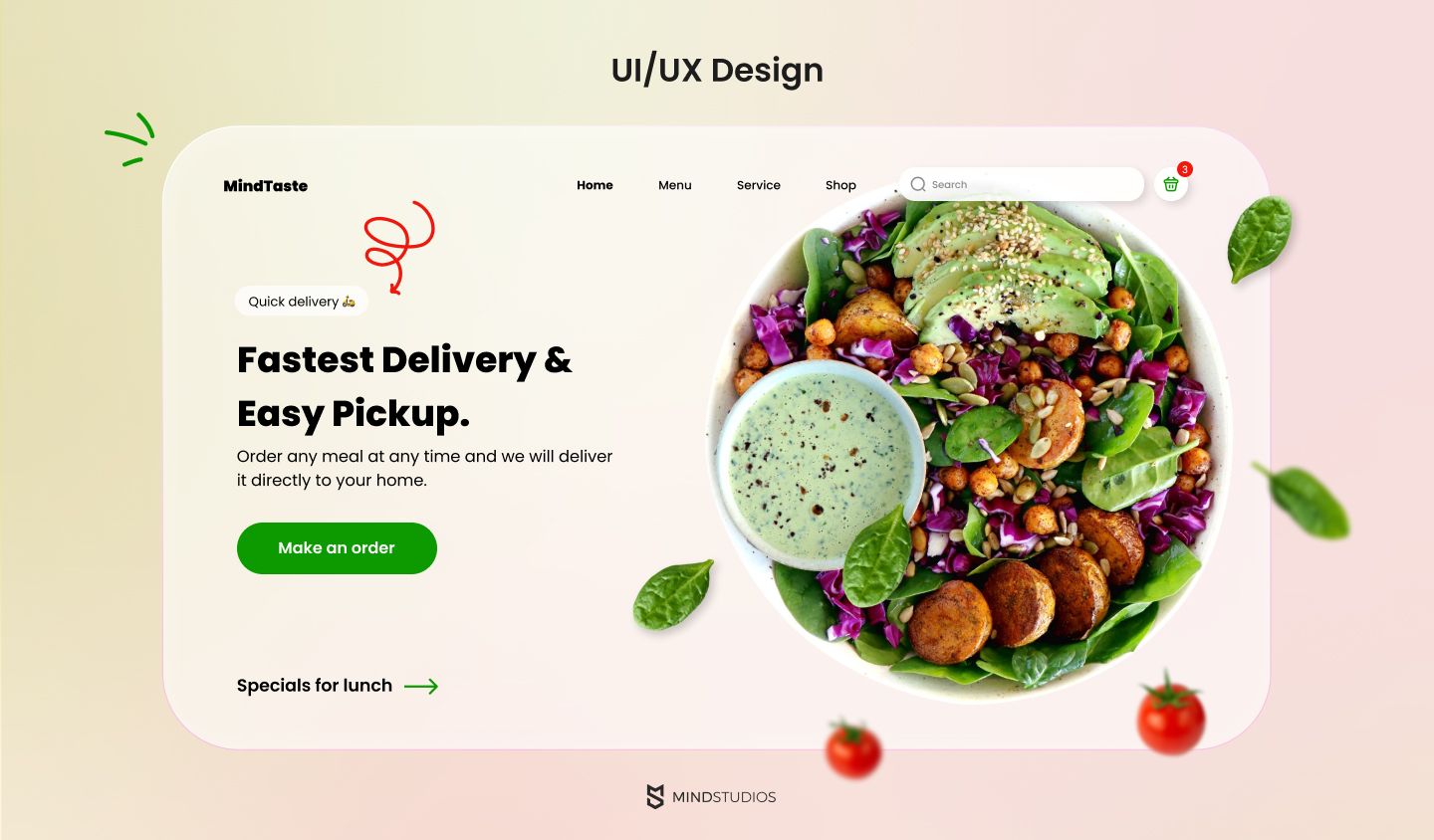
While a customer-facing food delivery website needs to be appealing and modern, following the latest design trends, a restaurant-side app needs to be simple to navigate first and foremost. It’s important for a responsible employee to be able to quickly accept and sort orders, so a no-clutter interface is best.
An admin panel is the last part you’ll need in your on-demand delivery system. It’s also usually the simplest in terms of design since it’s only seen by the service owner or a responsible employee. You don't need any bells and whistles here. In the admin panel, the main functionality you need is for adding and removing restaurants, managing money transfers between customers and restaurants, and managing delivery staff. You can add extra functionality if you’re planning to hold events, manage promo codes, or track user activity.
4. Development process
This step includes developing the server side, or the back end, which is necessary to connect different parts of the service. Your servers need to be secure since this is where all the data is kept for customers and restaurants alike.
Running a food delivery website development process, you can face issues regarding what type of database to use, how to overcome restrictions of a particular payment gateway, or what content delivery network (CDN) to choose to achieve high website performance. Apart from hiring a professional team of developers, an initial competitor analysis can come in handy as well. Choose websites you like and run them through BuiltWith platform. It’ll unveil what technologies your competitors use.
5. Quality assurance process
To be sure you’ll get a bug-free website, you need to involve quality assurance engineers to run different tests, to name a few:
- Code checking
- Accessibility testing
- Mobile ready testing
- Performance testing
- Security testing
- Cross-browser testing
- Beta-testing by real users
6. Choose your monetization strategy
To deploy a profitable food delivery service, you need to think over the efficient ways to generate revenue. You can take a page out of the five Uber Eats monetization models and build your own way to earn money by wisely combining them.
| Five Uber Eats’ monetization models | |
|---|---|
| Monetization models | Costs |
| Monthly subscription (so-called Eats Pass) |
|
| Commission |
|
| Fees |
|
| Sponsored listings |
|
| Uber gift cards |
|
The best time to define a monetization model is before starting the development of the food delivery website since how you’re going to make money directly impacts website architecture, payment methods used, and website design.
The lion share of successfully picked up monetization model largely belongs to preliminary unit economics’ calculation. By doing this, you’ll be able to identify which metrics you should increase or decrease to reach break-even point faster.
7. Launch an online food delivery website MVP
Launching any kind of business tends to be tricky and full of pitfalls, and meal delivery startups are no exception. Issues can come from anywhere: local government restrictions, inability to integrate a particular payment service, users’ lack of interest in using your platform, etc.
To validate your startup idea, the best and cost-effective method is building a minimum viable product first rather than a heavy-featured food delivery platform. After you get proof that your idea works well, you can enrich your website with follow-up matured features one-by-one, continuously testing them and analyzing feedback.
8. Adapt your website to the local market
When we were developing the James Butler delivery application for Danish people, we missed the fact that Stripe, a frequently used payment gateway, had limitations with instant payments in Denmark. To provide users with a convenient in-app instant payment service, we had to polish a Ruby-written conversion tool and collaborate with a respectable local Danske bank.
Working on Unight, a platform that allows users to access dining and clubbing venues in Shanghai, we also needed to pay attention to localization. Guided by Chinese preferences, we needed to integrate into Unight:
- QR-generating and scanning algorithms
- WeChat messenger
- Baidu notification system
As you see, adaptation to local market requirements goes far beyond language translation or currency conversion. You need to cater to local population preferences in dishes, diets, eating behavior, ways to order food. Moreover, you need to be aware of possible business constraints (corporate policy, government regulations, industry standards, etc.) and system restrictions (e.g. related to programming language used, third-party APIs, libraries, payment gateways).
We recommend you write a product requirements documentation (PRD) prior to your website development to sort out all requirements you need to adhere to.
9. Create useful content
One of the proven techniques to market your website is hosting a blog with relevant content for your users: recipes, rules for choosing groceries, different diets, and so forth. No less popular now is YouTube or TikTok videos with guidance on how to cook a particular dish. Interesting and entertaining posts on social media (e.g. your activities behind the scene or delivery curiosities) can also be a powerful source for increasing your website traffic and improving its retention rate.
Cost to make a food delivery website
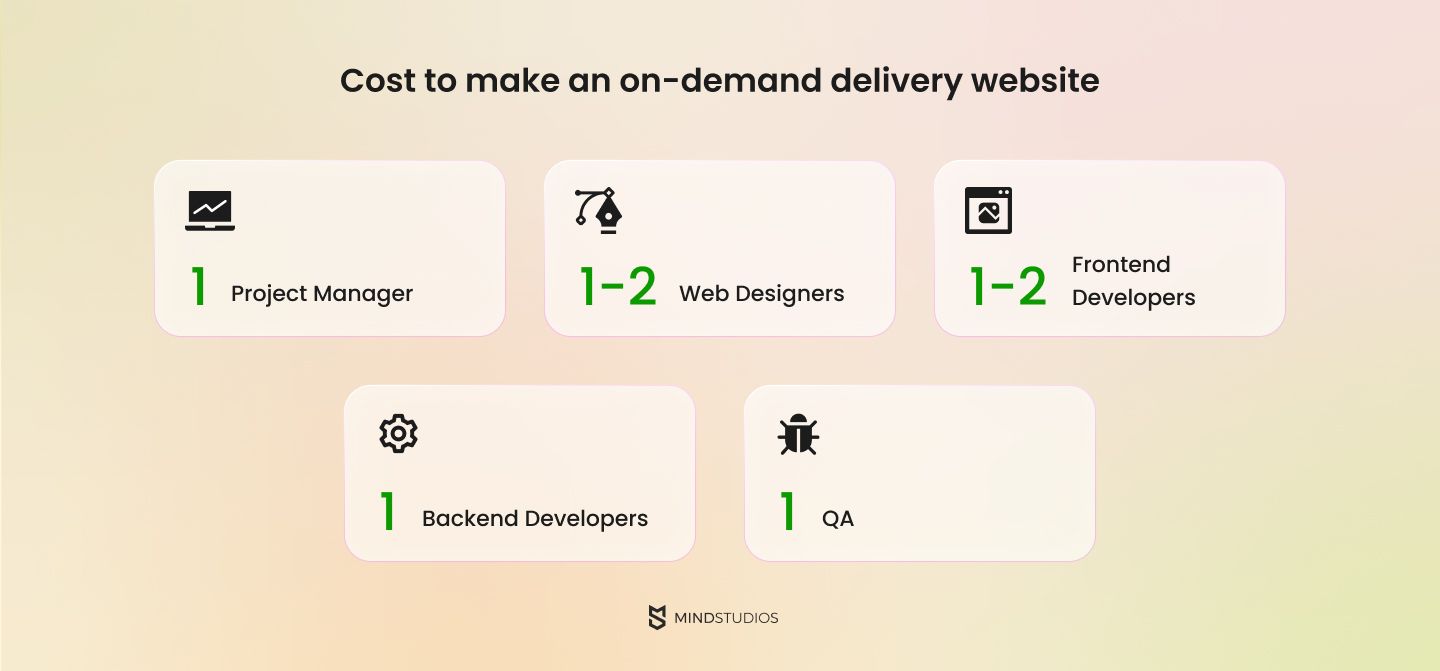
The cost to build a food delivery website isn’t set in stone, of course. Depending on the outsourcing website development company you hire, it can vary greatly. We can offer a rough estimate based on the specialists you’ll need for the job and the time it will take to complete.
The team to build a local food delivery website will look like this:
- 1 project manager
- 1–2 web designers
- 1–2 frontend developers
- 1 backend developer
- 1 QA specialist
One frontend developer can build web apps for customers and restaurants as well as the admin panel. But if you want to speed up the process, it might be worth it to have two or more developers. The same goes for web designers: while the restaurant-side app and admin panel don’t require anything fancy design-wise, dedicating a designer to these components will make things go faster.
Time-wise, developing a web-based on-demand delivery service will take two to four months. If you’re going with the minimum necessary team with one of each type of specialist, it will be closer to four months than two.
And with this team and term, the food delivery website development cost will start at about $61,000 for the features we’ve listed above. To provide you with a more specific estimate, we’ve put down the approximate time required for each development stage multiplied by a $40 hourly rate in the following table:
| Food ordering website development cost | ||
|---|---|---|
| Development stage | Hours | Cost |
| Project management | 100+ | $4,000+ |
| Frontend | 450+ | $18,000+ |
| Backend | 450+ | $18,000+ |
| Design | 168+ | $6,720+ |
| Admin panel | 126+ | $5,040+ |
| Testing and improving | 250+ | $10,000+ |
| Total | 1544+ | $61,760+ |
If your budget is limited, you can cut less important features to lower the cost. After all, you can always add features later when your website is launched and you start making a profit.
Mind Studios food delivery website development experience
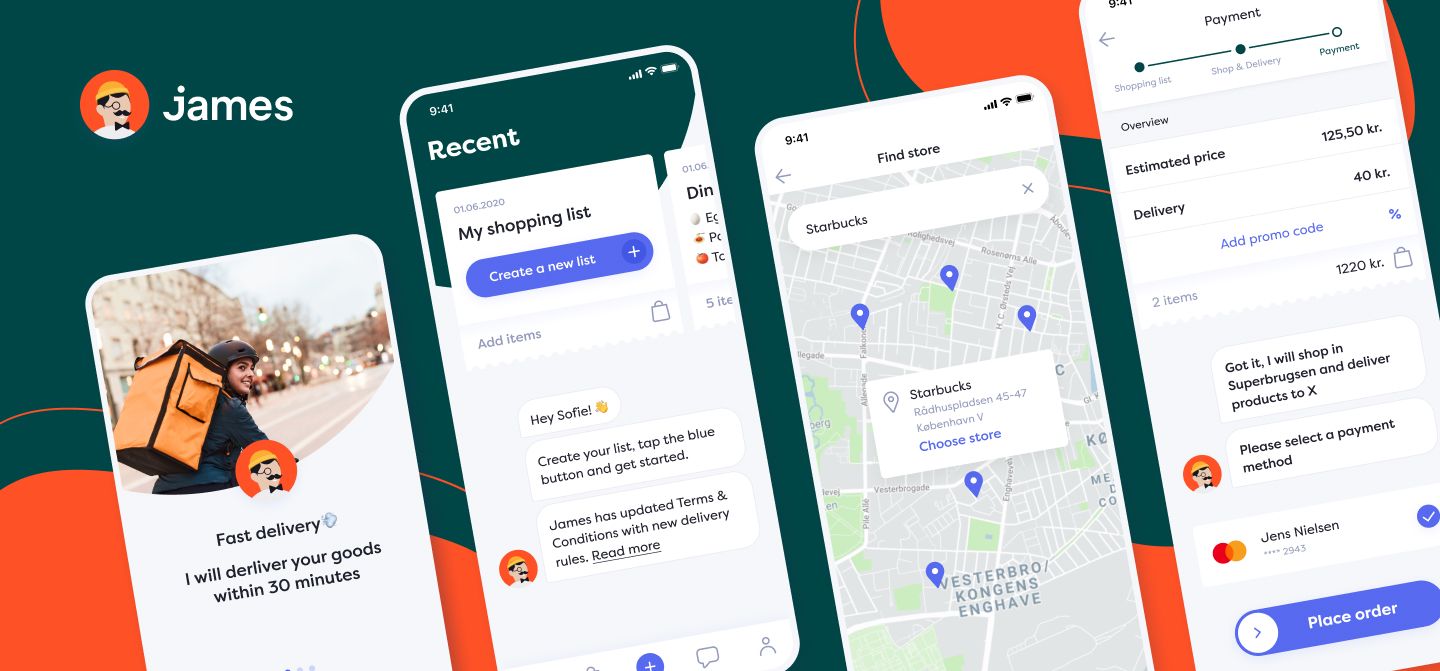
As we’ve mentioned, Mind Studios developers have experience in on-demand delivery website development. Three months after launch on both iOS and Android platforms, our delivery app James Butler received:
- Registered buyers — 4639
- Registered delivery people — 1946
- Shopping lists — 4972
- Orders — 4027
Moreover, James Butler app prompted a popular Danish singer Medina to invest in its marketing campaigns. One of them was a big advertising board placed on one of the buildings in the center of Copenhagen. See details of the food delivery app development process in our James Butler case study.
Conclusion
On-demand food delivery market is a highly profitable sector that can easily fit more players, especially now that consumers around the world are increasingly choosing local businesses rather than global corporations. There are niches here that are scarcely occupied, too — healthy and vegan food, for one. There are also cities and even countries where you’ll find few or no competitors at the moment. There’s never been a better time to jump in.
At Mind Studios, we have a seasoned team of professionals and can offer you both development and consulting services. If you have questions about how to build a food delivery website or if you’re looking for a cost estimate, reach out to us and we’ll get back to you with answers.


